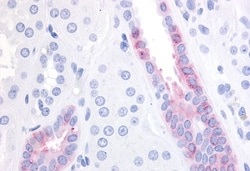Learn More
Invitrogen™ GPR1 Polyclonal Antibody
Rabbit Polyclonal Antibody
Supplier: Invitrogen™ PA532787
Description
Percent identity with other species by BLAST analysis: Human, Gorilla, Gibbon, Monkey (100%); Marmoset, Bovine, Bat, Elephant, Pig (94%); Dog, Horse, Platypus (88%); Panda (81%). For IHC(P), use heat induced antigen retrieval in pH 6.0 citrate buffer. After incubation with the primary antibody, slides were incubated with biotinylated secondary antibody, followed by alkaline phosphatase-streptavidin and chromogen.
The G-protein-coupled receptor (GPCR) superfamily is comprised of an estimated 600-1,000 members and is the largest known class of molecular targets with proven therapeutic value. GPR1 is an orphan receptor for the inflammation-associated leukocyte chemoattractant chemerin, suggesting a role for this receptor in the regulation of inflammation. In yeast, G protein-coupled receptor 1 senses glucose and controls filamentous growth. It acts upstream of adenylate cyclase and is required for glucose activation of cAMP synthesis in concert with a glucose phosphorylation-dependent mechanism.
Specifications
| GPR1 | |
| Polyclonal | |
| Unconjugated | |
| GPR1 | |
| Chemerin receptor 2; CMKLR2; G protein-coupled receptor 1; GPR1; Gpr-1; G-protein coupled receptor 1; probable G-protein coupled receptor 1 | |
| Rabbit | |
| Antigen Affinity Chromatography | |
| RUO | |
| 2825 | |
| Store at 4°C short term. For long term storage, store at -20°C, avoiding freeze/thaw cycles. | |
| Liquid |
| ELISA, Immunohistochemistry (Paraffin) | |
| 1 mg/mL | |
| PBS with 0.1% sodium azide | |
| P46091 | |
| GPR1 | |
| Synthetic 16 amino acid peptide from C-terminal cytoplasmic domain of human GPR1. | |
| 50 μg | |
| Primary | |
| Human | |
| Antibody | |
| IgG |
Safety and Handling
Your input is important to us. Please complete this form to provide feedback related to the content on this product.
